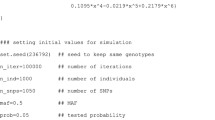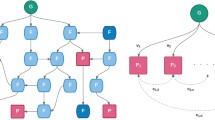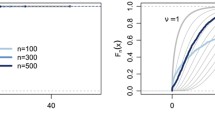Abstract
The power of bivariate variance components (VC) linkage analysis is affected by the size and source of the phenotypic correlation between variables. In particular, several authors have suggested that the power to detect linkage is greatest when the quantitative trait locus (QTL) and residual sources of variation induce phenotypic covariation in opposite directions, and that this increase in power is greatest when unique environmental sources of variation induce covariation in the direction opposite to the QTL. The purpose of the present study was to investigate further the effect of varying the residual correlation between variables on the power to detect linkage in a bivariate variance components linkage analysis. Data were simulated for a biallelic QTL that pleiotropically influenced two variables. The power to detect linkage was calculated under a variety of situations in which the proportion of phenotypic covariance resulting from shared sources of variation and from unique sources of variation was varied. These simulations were performed for the case in which the QTL affected the two variables equally and also for the case in which the QTL made unequal contributions to each variable. Our results confirm that the power to detect QTLs in a bivariate test for linkage depends upon the size and source of the residual correlation between variables, being greatest when the QTL and unique environmental sources of variation induce phenotypic covariation in opposite directions. We also found that when the QTL affected the two variables unequally, the power to detect linkage increased markedly as the correlation between unique environmental sources of variation increased from 0.6 to 0.9. Similar results were obtained under a variety of genetic models, including when there were unequal allele frequencies and dominance at the QTL. We suggest that a promising strategy to increase the power to detect QTLs might be to collect data from variables where there is either good observational evidence (e.g., from multivariate structural equation modeling of twin data) or a sound theoretical argument that the QTL and environmental factors induce covariation in opposite directions.
Similar content being viewed by others
REFERENCES
Allison, D. B., Thiel, B., St Jean, P., Elston, R. C., Infante, M. C., and Schork, N. J. (1998). Multiple phenotype modeling in genemapping studies of quantitative traits: Power advantages. Am. J. Hum. Genet. 63:1190-1201.
Amos, C., de Andrade, M., and Zhu, D. (2001). Comparison of multivariate tests for genetic linkage. Hum. Hered. 51:133-144.
Boomsma, D. I. (1996). Using multivariate genetic modeling to detect pleiotropic quantitative trait loci. Behav. Genet. 26: 161-166.
Evans, D. M. (2002). The power of multivariate quantitative trait loci linkage analysis is influenced by the correlation between variables. Am. J. Hum. Genet. 70:1599-1602.
Eysenck, H. J., and Eysenck, S. B. G. (1975). Manual of the Eysenck Personality Questionnaire. New York: Crane, Russak, & Co.
Health, A. C., and Martin, N. G. (1990). Psychoticism as a dimension of personality: A multivariate genetic test of Eysenck and Eysenck's psychoticism construct. J. Pers. Soc. Psychol. 58:111-121.
Kinderman, A. J., and Monahan, J. F. (1977). Computer generation of random variables using the ratio of uniform deviates. TOMS 3:257-260.
Martin, N., Boomsma, D., and Machin, G. (1997). A twin-pronged attack on complex traits. Nat. Genet. 17:387-392.
Martin, N. G., and Eaves, L. J. (1977). The genetical analysis of covariance structure. Heredity 38:79-95.
Pearson, E. S., and Hartley, H. O. (1972). Biometrika tables for statisticians, Vol. 2. Cambridge: Cambridge University Press.
Self, S. G., and Liang, K. (1987). Asymptotic properties of maximum likelihood estimators and likelihood ratio tests under nonstandard conditions. J. Am. Stat. Assoc. 82:605-610.
Sham, P. C., Cherny, S. S., Purcell, S., and Hewitt, J. K. (2000). Power of linkage versus association analysis of quantitative traits, by use of variance-components models, for sibship data. Am. J. Hum. Genet. 66:1616-1630.
Author information
Authors and Affiliations
Rights and permissions
About this article
Cite this article
Evans, D.M., Duffy, D.L. A Simulation Study Concerning the Effect of Varying the Residual Phenotypic Correlation on the Power of Bivariate Quantitative Trait Loci Linkage Analysis. Behav Genet 34, 135–141 (2004). https://doi.org/10.1023/B:BEGE.0000013727.15845.f8
Issue Date:
DOI: https://doi.org/10.1023/B:BEGE.0000013727.15845.f8




